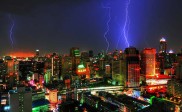How to Succeed in Photographing Interiors
Photographing Interiors
Interior photography is a very interesting form of photography. If you are selling your house, creating a portfolio of you decor creations, or just for the pleasure of it, taking good photos of interiors is a very valuable skill which will serve you even in other kinds of photography. Interior photography comes with many obstacles which may impede the enthusiastic photographer. These obstacles are generally related to equipment and lighting. Once you overcome them, you only need to work on your composition skills to get great interior photos. This article will present you with some tips and technique to succeed in interior photography.
Interior Photography Equipment:
-Camera: Although you can succeed in taking descent pictures using a compact or a bridge camera, you need a DSLR in order to get the best results possible. SLR cameras will provide you with the comfort of producing good image quality even in poor lighting and with high ISOs, and will enable you to use a wide variety of lenses for the different conditions and places you are going to shoot in.
– Lenses: You can use the standard 18-55 lens which comes with your camera body, but it’s always better to have different alternatives for different situations. The most important lens to acquire for shooting interiors is a wide angle lens. In most cases, you will be taking photos in a reduced space and you need a wide angle lens to cover the different elements and sides of a small room. Something like the Canon 10-22mm or the Nikon 10-24mm can be all what you need. Don’t bother getting lenses with wide aperture capabilities, since in interior photography you will be most probably using a tripod and small apertures for a wide depth of field.
– Light: Unless you have many external flash units and you master lighting with flashes, it’s better to use the ambient light of the room you are shooting.
– Tripod: This is a crucial accessory for interior photography. You will be shooting with slow shutter speeds and you need sturdy support for your camera to avoid any camera shake. Consider getting a regular tripod as well as a table-top tripod to be able to adapt to different situations. You can also use a small stool to stand on, especially when photographing really small spaces.
-Editing Software: Interior photography is all about aesthetics. You need to re-transcribe the place in front of you in the best possible way. For this, editing software like Photoshop can be really helpful.
– Other accessories: other accessories like a remote release for avoiding touching the camera in long exposures and a flashlight for some light painting can contribute in getting perfect shots

Photo by /\ltus
Lighting:
The problem with artificial lighting is that it produces harsh shadows (because of its small size) especially if there is only one light source in the place you are shooting. Although you can make use of such light if you are aiming to capture the exact atmosphere of the place , most of the time it’s better to have diffused light to capture interior photographs. You can achieve this, through simply reflecting your light source on a nearby ceiling or wall. Another alternative to artificial light is to use natural light which can be all what you need if you are seeking to capture the atmosphere of the place and you don’t care if you loose some details here and there.
The intensity of the light doesn’t really matter, as you can use long exposure times and a tripod (your subject won’t go anywhere after all). What’s more important is the quality of your light (size, color…) and its direction. SO, you need to pay close attention to your white balance setting, as artificial light can easily mislead cameras. You will find in your camera menu different option for setting the white balance according to the type of light you are using (incandescent, fluorescent …) but the best way to set it is through exactly telling the camera what to consider as white. This can be done through an option present in most cameras where you take a photo of a white or gray surface under the lighting you are using and the camera will set its white balance according to the photo you took.
Another problem which you might encounter, when photographing interiors with a window within the composition, is that the light coming from the window and the light in the room you are shooting have different intensity which in turn will make getting a proper exposure tricky. You can solve this problem by taking two different exposures of the same scene, in one exposure you will have he walls and details of the room properly exposed and the scene behind the widow overexposed, and in the second one you will get a properly exposed exterior scene and an underexposed interior. After that you can combine the two shots in an editing software like Photoshop to create one photo which shows details with an accurate exposure all over the frame. If you don’t have any Photoshop skills, an alternative is to wait for the perfect moment to take the photo. In this case, you need to observe the room or space you are photographing at different times of the day and to shoot at the moment where the light coming from the window and the light inside are in some kind of balance and equally intense.
Shooting Tips:
After overcoming all the obstacles relating to equipment and light, an equally important part to consider is the shooting stage. This is where you will show your talent as a photographer through composition and choosing your point of view. Here are some tips to help you in this process.
– Lines: As with any kind of architectural photography, the lines in your composition are very important. So, make sure when composing that your verticals are really vertical and your horizontals are really horizontal. A good method to guarantee this is by using the gridlines of your camera when composing and using a tripod with a level indicator.
– Rule of thirds: Another great use of the gridlines is in composing your shot. They can help you determine the different thirds of your frame in order to place your most prominent elements on one of the intersecting lines of the grid.
– Point of view: You need to choose a point of view which will help the viewer understand the structure and nature of the interior you are shooting. It can be hard to find a good point of view to shoot from especially in confined spaces. This is where the small stool will be valuable. Shooting from a high point of view can be a great solution in such situations, as it will help you get in your frame the maximum of the space you are shooting.
– Depth of field: apart from some shots where you are concentrating on a small detail, you need a really large depth of field to make sure every element of the interior is in focus. For this, you need to use a small aperture. The aperture will be determined by the lens you are using and by the size of the interior, but something around F/8 or F/11 will get you great results in most cases.
– ISO: Try to use low ISO values to avoid any kind of noise that may appear on your image.
Editing:
The editing stage can be as simple as adjusting light and contrast or can be as advanced as creating photo composites, HDRs, and extensive use of layer masks. It all depends on your editing skills, the software you are using and the extent to which you succeeded in capturing your initial shot. Overall, for most of the photos, try to adjust levels, and inspect color balance and to adjust it if needed.
Following are some great examples of interior photography:

Photo by Lens Adventurer

Photo by Light+Shade

Photo by LightAsMagic

Photo by Mike Chen

Photo by Bakar_88

Photo by Stuck in Customs

Photo by Thomas Hawk

Photo by seier+seier

Photo by NancyHugoCKD
If you liked this article about interior photography, don’t forget to add a comment in the section below.




thanks very much for the article! I am doing my first shoot for a realtor tomorrow as a practice run, and this helped!Cheers